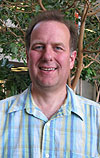Bill Lee is new Minos underground areas coordinator
 |
|
Bill Lee |
Bill Lee has taken over as Fermilab's new Minos underground areas coordinator now that the former underground coordinator, Aria Soha, has moved on to work on the Muon g-2 project. Lee worked as the run coordinator on the DZero experiment from 2000 until the fall of 2012.
As Minos underground areas coordinator, Lee will oversee all underground operations, ensuring that construction, experiments and other underground happenings run smoothly and without interfering with each other.
"Right now it's very exciting because we've got the NOvA experiment coming in," Lee said. "You've got to make sure that you can get all of these pieces into the hall and also make sure you can keep the other experiments running, since we expect beam soon."
As a graduate student, Lee worked on the NuSea experiment at Fermilab, which investigated the nuclear sea. After graduating in 1999, he worked on DZero as a postdoc at Florida State University before eventually being brought on as the experiment's run coordinator. He left the lab for six months beginning in October, teaching ultrasound physics at Sanford Brown College. He returned to Fermilab in April.
"I liked teaching," he said. "But I like doing research. One of the things that I've always liked to do is to make things work."
In his capacity as underground coordinator, Lee will still get to do some teaching in the form of giving tours to both employees from other areas of the lab and anyone outside the lab who has an interest in how it works.
"I think it's really important that we give tours to people outside of Fermilab," Lee said. "So many people don't understand what we're doing, and it's really important to be able to take them and show them exactly how these detectors work and what we're trying to do and tell a little about what we're trying to learn."
—Laura Dattaro
|